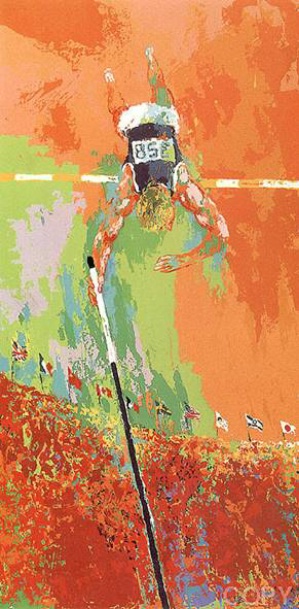
Although art is no longer part of the Olympics, it has still reflected sports achievements. This serigraph by LeRoy Neiman depicts pole vaulting at the Liberty Bell Classic in 1980, when America and 61 other countries boycotted the Olympics in Moscow protest of the Soviet invasion of Afghanistan in December of 1979.
Did you know that creating works of art used to be an Olympic competition? For a brief 36 years, from 1912 to 1948, painters, sculptors, architects, writers, and musicians participated at the real Olympic Games. In the first year of the inclusion of arts in the Olympics, Walter Winans became the first–and only–Olympian to win medals for both art and sports. Winans was a Russian aristocrat with American citizenship who won a silver medal for team USA in the shooting event “Team Running Deer—Single Shot” and a gold medal for his sculpture An American Trotter. Despite this seemingly optimistic start, the idea of the arts being included in the Olympic Games was soon met with disinterest, finally resulting in the removal of the art competition of the Olympic Games. The unique history of this part of the Olympic Games is filled with missteps, which is why it is no longer a part of the Olympics today.
Why Make Art an Olympic Discipline?
The idea to include art in the Olympics came from Baron Pierre de Coubertin, who was the founder of the IOC, which created the modern Olympics. Coubertin believed that the arts and sports were linked and was impressed by anyone who had a firm command of both a sport and an artistic discipline. Richard Stanton, author of The Forgotten Olympic Art Competitions, told Smithsonian Magazine that “he felt that in order to recreate the events in modern times, it would be incomplete to not include some aspect of the arts.”
Why Aren’t the Arts Included in the Olympics Today?
There are several reasons why the idea of including arts in the Olympic Games did not survive to today’s Olympics. From the very beginning, the idea of including arts in the Olympics was met with opposition. It wasn’t until 16 years after the modern Olympics began, in 1912, that medals were finally awarded to artists. However, due to the poor standards that dictated how the art competition was run, the art portion of the Olympics Games was soon disbanded.
For starters, only amateurs were allowed to compete in the arts portion of the Olympics. This means that many famous artists who would have garnered international attention and interest, like Pablo Picasso or Frida Kahlo, were banned from participating. Having mediocre artists competing while only the best, most competent athletes were allowed to compete created a dramatic divide and gave the impression that the arts were not as important as sports. This guided public interest to favor the sports part of the Olympics much more than the arts portion.
Secondly, all of the art created had to have sports as the subject matter. This rule made all of the art produced seem tedious and repetitive. Curtailing the subjects that artists could create their art about also contributed to making the arts part of the Games boring to the general public.
Finally, one of the biggest reasons for disinterest in the arts was that the arts are subjective. Sports can be judged by solid metrics, like time and distance, which make it easy to determine who is the winner. Arts, on the other hand, are not quite so easy to judge. This difficulty in judging a definite winner, compared with public disinterest, resulted in the arts portion of the Olympics to be demoted to a non-competitive exhibition that ran for the duration of the games.
Keep up with our blog for the latest art news.
Questions? Call Patty Barnett at 504.524.2922
Like us on Facebook and follow us on Twitter and share with your friends.
Source: 1
Tags: art history, Olympic, Olympic Games, Olympics





